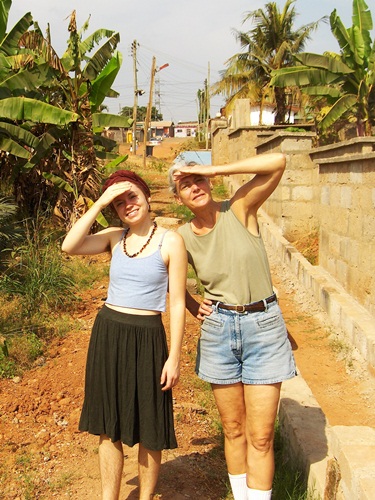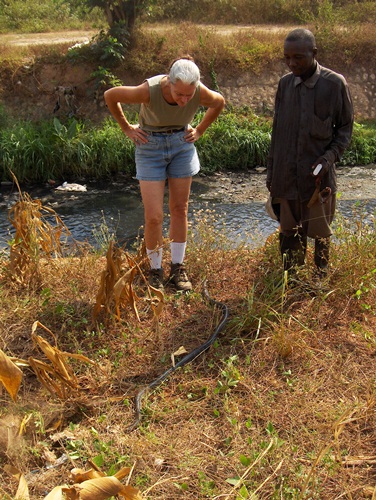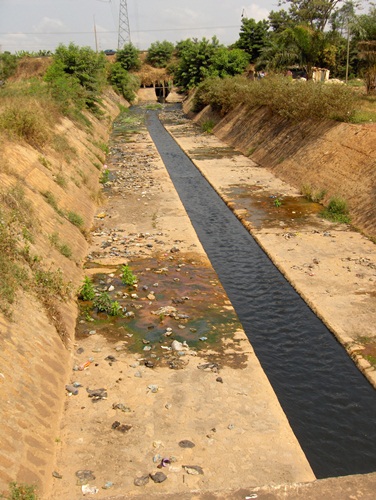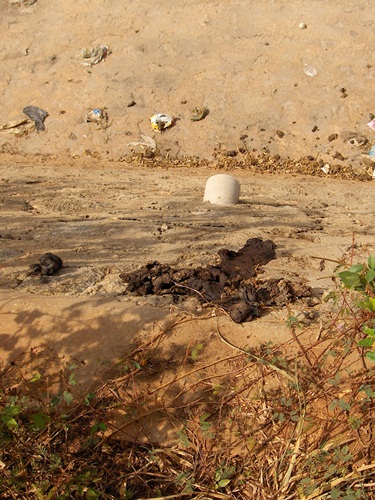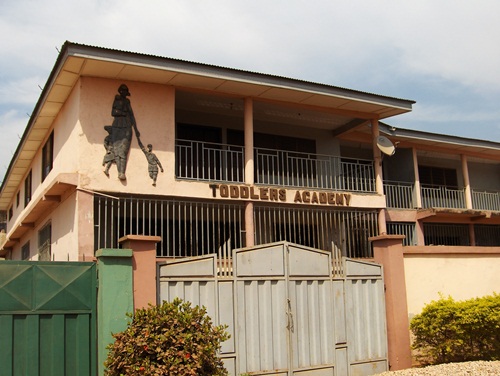A walk through the rice fields in what was once the Kumasi Forest Reserve on January 27, 2013
WALKING INTO A NEW DAY
On the equator, the sun rises straight up with little time to lose. By 9am it’s already high enough to make us squint as Amy, Camille and Bob step back into the rice fields east of our neighborhood. This field belongs to a farmer named Malik who covers it with netting to keep the birds from eating his crop. We found out that we can purchase thirty kilos of rice grown right here if we wish. It turns out Malik and Peter, the rice farmer we met in September who farms on the other end of this urban valley are brothers.
SEEN ANY SNAKES?
Bob asked, as he usually does if Malik had seen any snakes lately. “Yo, I saw one black snake this morning. Would you like to see it?” and he took us to the spot where he had flung the dead snake over the side of the ditch, pulled it back up and laid it out, about seven feet or so. It was still tangled in the bird netting so Camille pulled her pocket knife out and Mallick cut it free so we could get a good look. Bob reached down and pulled the extra skin alongside the snake’s neck and we all agreed it was a cobra. He hesitated for a few moments, tempted to skin it with his pocket knife. We were careful not to touch the snake’s head and mouth as venom is just as deadly after the snake has died. Once home, Bob identified it as a black-necked spitting cobra (Naja nigricollis).
PLANT MAMA


Amy has fallen head over heels in love with the magical plant world.
VAGUELY FAMILIAR


Amy is challenged and surprised by many of the plants that grow here at six degrees north of the equator, since they are somewhat familiar yet quite different from the plants she has come to know at thirty-five degrees north.
SANITATION
We’ve come to Ghana to address water sanitation issues. This ditch is a case in point. Smelly, garbage filled and an open toilet for the farmers, herders and charcoal makers who live in shacks surrounding its concrete banks.
IF IT SMELLS BAD, WEAR IT


Camille brought a bandanna which came in handy at one point to help filter the stench emanating from the ditch. Moving along at a fast pace helped reduce the time spent along this particular stretch.
A NEW GENERATION
We have several schools in our neighborhood, including this one. During the week we can tell the time by listening to the children’s voices as we move about our day. We hear them gather in the school yard before class, the 10:00-10:30am crescendo of joyful play at recess, the 1:30 after-lunch recess and 3:00 end of the school day when uniformed youngsters spill back out into the streets. Mothers, fathers, uncles, brothers and sisters also fill the streets on their way to meet the younger children and walk them home. Mothers, aunties and older sisters tie a piece of cloth around their torso and wrap the children too young for school inside.
There are a lot of children here. One of the first things a new acquaintance will ask is, “How many children do you have?” The other day Bob, Amy and Camille saw at least fifteen young children in a saloon car (sedan) heading off to school. All we could see was the tops of their heads as we walked past the car. They sat in laps and stood on the floor. A bobbing sea of fuzzy heads. Unlike the States, seat belts and car seats are not mandatory. In fact, we have yet to see a car seat and most of the back seat belts are inoperable.
You may be thinking, “No wonder the infant mortality rate is higher in Ghana than it is in the United States!” but the higher rate has much more to do with the three M’s, Malnutrition, Malaria and Measles than lack of car seats and snugglies. Time for a little demographic comparison. The Ghanaian birth rate is roughly twice the birth rate in the United States (26.99 per 100,000 vs. 13.68). The infant mortality rate in Ghana is 50.64 (per 100,000) compared with 6.64 in the States or roughly 7.5% higher. To put this into perspective, the highest infant mortality rate is 122 in Afghanistan and the lowest is 2 in Monaco.
BEAUTY IN A WALL

We were impressed by the pattern of shells used to decorate a this wall on the street behind our house.
So ends our tour of the rice fields, from residential street, to fields, to the ditch and back again. We hope you enjoyed the walk. Here is the photo essay from our previous wander through the rice fields with Jeremy on September, 2012: Wetland Walk
____________________________________________________________
[Latest] * [Troutsfarm] * [Casa Kumasi] * [Osda House] * [The Big Pineapple] * [Memory Lane, Tema] * [FS2BD January 3013] * [Walking Through the Rice Fields] * [Shopping at Nadville]
____________________________________________________________
